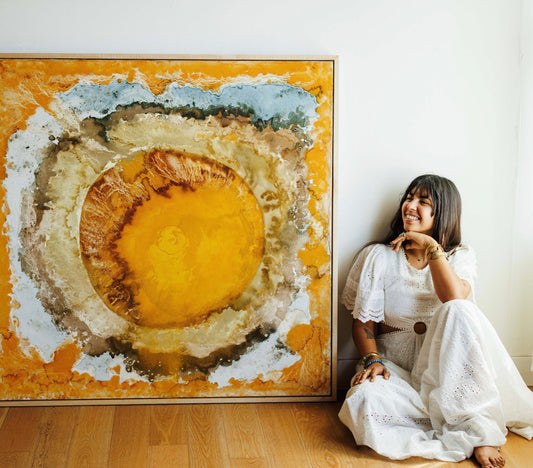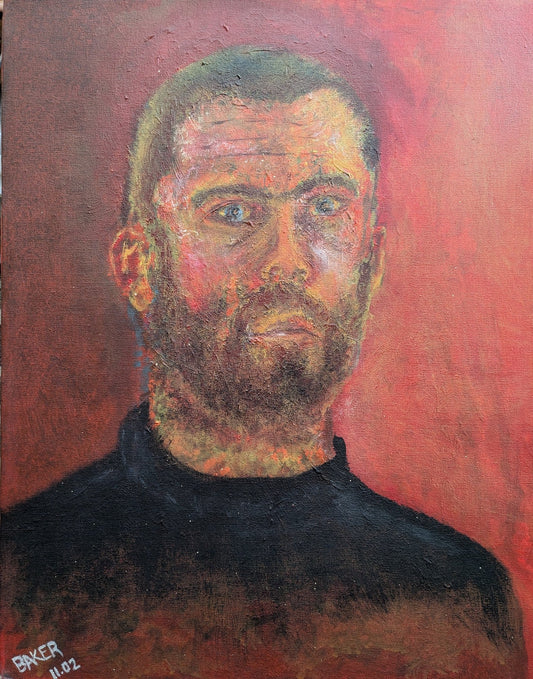It’s always refreshing to hear a new take on an old story. For me, it gets even more intriguing when the fresh take surrounds art—and not just any art, but the kind that reclaims, heals, and breaks an old tradition’s social boundaries. I certainly felt refreshed and energized after an hour-long conversation with self-taught painter and illustrator Laura James, whose art ranges from reimaginations of biblical scenes influenced by Ethiopian-iconography to surrealist-inspired depictions of her childhood.

James and I both hurriedly logged onto our zoom call a few minutes late, adjusting our seats and settling in. Despite James’ almost immediate admittal that she barely slept the night before our call, her remarks were fascinating, fine-tuned, and always made their way to a crucial point.
James was born and raised in what she describes as the Caribbean Brooklyn, specifically Bedford and Bed Stuy. She remarks, “It was Brooklyn, but we were around Caribbean people, food, and the culture.” This New York-Caribbean influence is obvious in the lively patterns, tropical natural elements, people, and food in her artwork.


We continued down memory lane as I asked James about her most memorable body of work. Without hesitation, she replied, “The book of gospels I illustrated for LTP (Liturgy Training Publication).” James worked on this project over the course of four months in 2016 and the most memorable part of this project was, as she put it, “seeing the actual book for the first time. It is a really big heavy book, and I did not know anything about it or what they really did with it in the Catholic church in particular.” When she was hired for the project, James had already painted 11 pieces from the Book of Gospels and was very familiar with it. Despite James’ familiarity with these stories, the large presence and shiny quality of the book really struck her. Maybe the large, shiny quality of the book reminded James that it has so much historical significance. It is one thing to know a book’s stories through and through, and it is another to reimagine such an important piece of history in an entirely new light.

Most of James’ work arrives at this destination: What does it mean to reimagine 2,000-year-old stories, today? While finding the answers to this question throughout her career, Laura has navigated a complex relationship with Christianity and early on, “was really conflicted with Christianity. It’s not something that I was wanting to promote. From the word on the street, it was known as ‘the colonizer’s religion. It was not so great but the message was there …’” At this same moment, churches were not buying her work and she began painting more secularly. However, she stated, “Very shortly after this, I was called upon to do the Book of the Gospels and it was a wonderful project. Ever since then, I’ve been painting this way.” ‘This way” means recreating biblical narratives with an Ethiopian-Iconographic influence that represent Black people in Christian stories—something that has rarely been done. From what I gather, James is a lover of history, story-telling, and recreating previously understood narratives with new meanings. Her reimagined biblical stories encapsulate all of these aspects. At the beginning of our call, she said, “There has to be something to Christianity, right? I mean, it cannot just be dismissed. It has lasted as a daily practice for 2,000 years. You cannot say the same for many other things.” And she’s right.

So, for someone making this claim and painting as many biblical scenes as she does, I was sort of surprised when she said, “I don't believe in heaven and hell. I really don’t. And when you don’t believe in heaven and hell, Christianity sort of loses its bite.” Talk about a refreshing take. She went on to say, “So what is Christianity really about? It can be so weird and there are so many contradictions in the bible. And, after a lot of studying, I’ve found that Christianity has really gone off course … but there are plenty of people who want to change that.”
James is one of these people. She sees the hope in Biblical stories, understands Christianity’s problematic past, yet sees a brighter future. Her art exists as a tool to reclaim Christianity through the power of representation in biblical narratives. During our call, James told me an inspiring anecdote about a young Black artist she came across online. James was so moved by the artist’s work that she eventually reached out. Come to find out, this artist grew up in a church that used James’ Book of Gospels. She finished the heartwarming story with, “and that’s what it's about, right? He grew up seeing something different. We need this.” Maybe without even knowing it at the time, James inspired an entire generation of upcoming Black artists through the representation of Black people in depictions of Christianity that have historically been white, even in Black spaces.


To me, in addition to so many other things, James acts as a translator for a previously misinterpreted language. And really, the Bible has been quite literally misinterpreted so many times. James and I spoke about these mistranslations when she said, “You hear of people reading [the Bible] in different languages and the different words that they thought meant this and meant that and it really turns the whole thing upside down. There was this one story where Jesus was supposed to be a carpenter, right? And apparently the word was meant to be a stone mason, and that makes more sense in the story, anyway. There are so many words, phrases, and terms where the meaning is very different from what we think. And what does that mean? Is the entire religion now shot to hell? Well no. It’s not about that. It’s not about words on the page.” And she’s right. There is so much more to it than just words on a page, her art being one of these important aspects. James takes these previously understood biblical tales and redefines them, transforming them into the images that are now her own, and hold new meaning.

James is currently using these transformative skills on a Mary Magdalene project aiming to reclaim the original understanding of Mary Magdalene. Over time, various interpretations of Mary Magdalene became fictional, varying greatly from what was originally written about her. James has been called upon to, as she put it, “go back to the Bible.” So, James can do both. She reclaims biblical stories like The Book of the Gospels, and brings them back to their original roots like Mary Magdalene.
While a lot of my eye-opening conversation with Laura was spent on her interpretations of the Bible, she also has an array of secular work as a children’s book illustrator. Later this year, her third children’s book “My Mother Was a Nanny” will be published. It is a book about her own mother, who was a nanny, and her childhood. James hopes this book, much like all of her other art, will be a conversation starter and as James put it in her own words, “showing some people who may not be well-represented in popular culture in many stories. Nannies are not always so well respected. So I have this series of paintings highlighting Nannies. I want to show these women as the backbone of the society that they are.” Yes, Laura!
Among so many other things, my conversation with Laura James reminded me that representation is the most powerful thing, and when we are called upon to do something, just as Laura has been called upon to create her incredible art, we just have to do it.
©ArtRKL™️ LLC 2021-2023. All rights reserved. This material may not be published, broadcast, rewritten or redistributed. ArtRKL™️ and its underscore design indicate trademarks of ArtRKL™️ LLC and its subsidiaries.





